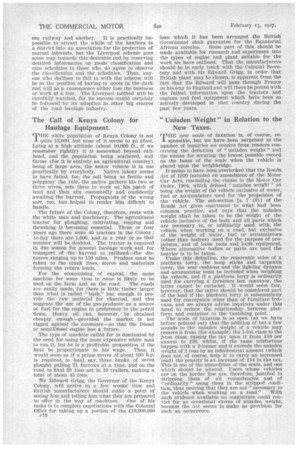"Unladen Weight" New Taxes. in Relation to the
Page 40

If you've noticed an error in this article please click here to report it so we can fix it.
rilHE new scale of taxation is, of course, re sponsible, but we have been surprised at the number of inquiries we receive from readers concerning the definition of "unladen weight" and the means for securing the lowest possible record on the beam of the scale when the vehicle is placed upon the weighbridge. It seems to have been overlooked that the Roads Act of 1920 included an amendment of the Motor Car Acts, rescinding the clause in the Motor Car Order, 1904, which defined "unladen weight" as being the weight of the vehicle exclusive of water, fuel or accumulators used for the propulsion of the vehicle. The sub-section [s. 7 (6)1 of the Roads Act gives enactment to what had been common practice, and says that the unladen weight shall be taken to be the weight of the vehicle inclusive of the body and all parts which are necessary to, or ordinarily used with, the vehicle when working on a road, but exclusive of the weight of water, fuel or accumulators (other than boilers) used for the purpose of propulsion, and of loose tools and loose equipment. Where alternative bodies or parts are used the heavier is to be taken. Under this definition, the removable sides of a platform lorry, the hoop sticks and tarpaulin cover, the seat cushions and the lighting dynamo and accumulator must be included when weighing the vehicle, and if a platform lorry is ordinarily used for carrying a furniture box conveyor, the latter cannot be excluded. It would seem fair, however, that the latter should be considered part of the load if the platform lorry is substantially used for conveyance other than of furniture boxvans, and we always advise inquirers under this head to reduce the relationship between platform and container to the vanishing point. The scale of taxation is so open (as we have before pointed out) that the addition of but a few pounds to the unladen weight of a vehicle may remove It from (for example) the 1.-ton class to the 2-ton class, raising the tax upon it from 1.16 per annum to £26, whilst, if the same misfortune happen with a 2-tonner and it exceeds the unladen weight of 2 tons by an infinitesimal amount (which does not, of course, help it to carry an increased load) the penalty is an increase of £14 in the tax. This is one of the absurdities of the scale, and one which should be altered. Users whose vehicles are on the border line are, therefore, justified in Stripping them of all redundancies and of "ordinarily" using them in the stripped condition, thus proving that they are not "necessary to the vehicle when working on a road." With such evidence available no magistrate could convict for an occasional excess of unladen weight, because the Act seems to make no provision for such an occurrence.












































































































